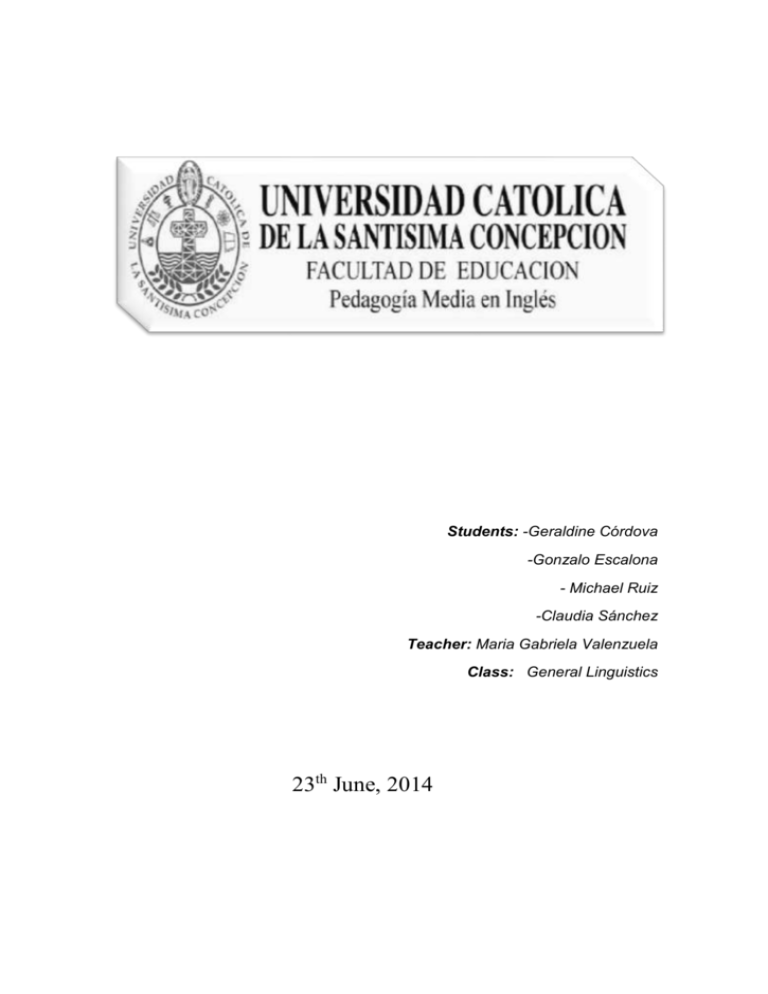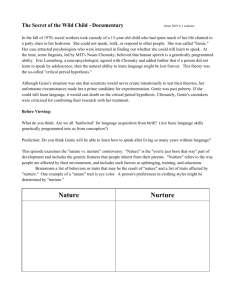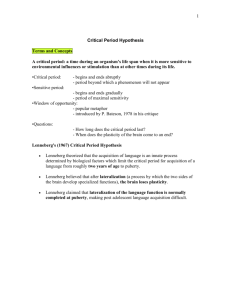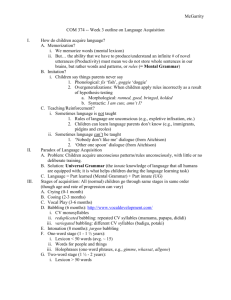File
advertisement

Students: -Geraldine Córdova -Gonzalo Escalona - Michael Ruiz -Claudia Sánchez Teacher: Maria Gabriela Valenzuela Class: General Linguistics 23th June, 2014 Introduction Language acquisition is restricted only to human behavior as well as being a defining characteristic of it. Today, that maternal mother tongue comes from imitation of the linguistic environment. Until 1957 linguists have this same belief. Until Noam Chomsky, pose his theory of language acquisition. His theory revolutionized the scientific view of language acquisition when it was finally accepted in the 60s. As a consequence, he was responsible for the emergence of a new field during the 1960s, Developmental Psycholinguistics, which deals with children’s first language acquisition. Chomsky was not the first to question our acceptance of a hitherto silent debatable concept - long before Plato wondered how children could possibly acquire a complex skill like language with so little life experience. Experiments clearly identified the ability to distinguish syntactic nuances in young children, even when they are the pre-linguistic. Children of three, however, are able to manipulate very complicated syntactical sentences, but are unable to tie their own shoelaces, for example. In fact, language is not a skill, like learning to ride a bike or do math – that it cannot be taught as such in these early stages.Noam Chomsky turned the world's eyes to this puzzling question at a time that is supposed to have a seemingly simple explanation. Who was Noam Chomsky? Born in Philadelphia on December 7, 1928, Noam Chomsky was an intellectual prodigy who went on to earn a PhD in linguistics at the University of Pennsylvania. Since 1955, he has been a professor at MIT and has produced groundbreaking, controversial theories on human linguistic capacity. Chomsky is widely published, both on topics in his field and on issues of dissent and U.S. foreign policy. Language Acquisition; what is it? It is a natural, unconscious progression or development of language. It is a process that occurs through language use in ordinary conversation and is the typical progression by which infants and young children first learn to talk. There are two concepts in language acquisition which are nurture and nature. Today, most researchers acknowledge that both nature and nurture play a role in language acquisition. However, some researchers emphasize the influences of learning on language acquisition, while others emphasize the biological influences. Receptive Language before Expressive Language Children’s ability to understand language develops faster than their ability to speak it. Receptive language is the ability to understand language, and expressive language is the ability to use language to communicate. If a mother tells her fifteen-month-old child to put the toy back in the toy chest, he may follow her instructions even though he can’t repeat them himself. Environmental Influences on Language Acquisition A major proponent of the idea that language depends largely on environment was the behaviorist B. F. Skinner. He believed that language is acquired through principles of conditioning, including association, imitation, and reinforcement. According to this view, children learn words by associating sounds with objects, actions, and events. They also learn words and syntax by imitating others. Adults enable children to learn words and syntax by reinforcing correct speech. Critics of this idea argue that a behaviorist explanation is inadequate. They maintain several arguments: Learning cannot account for the rapid rate at which children acquire language. There can be an infinite number of sentences in a language. All these sentences cannot be learned by imitation. Children make errors, such as over regularizing verbs. For example, a child may say Billy hitted me, incorrectly adding the usual past tense suffix -ed to hit. Errors like these can’t result from imitation, since adults generally use correct verb forms. Children acquire language skills even though adults do not consistently correct their syntax. Neural Networks Some cognitive neuroscientists have created neural networks, or computer models, that can acquire some aspects of language. These neural networks are not preprogrammed with any rules. Instead, they are exposed to many examples of a language. Using these examples, the neural networks have been able to learn the language’s statistical structure and accurately make the past tense forms of verbs. The developers of these networks speculate that children may acquire language in a similar way, through exposure to multiple examples. Biological Influences on Language Acquisition The main idea of the view that biological influences bring about language development is the well-known linguist Noam Chomsky. Chomsky says that the human brain has a language acquisition device, which is an innate mechanism or process that let children improve language skills. According to this point of view, all children are born with a universal grammar, which makes them receptive to the common properties of all languages. That is why this hard-wired background in grammar, children easily pick up a language when they are exposed to its particular grammar in a quickly way. Proofs and fundamentals for innateness capacity to acquire language skills come from the following observations: The stages of language development occur at about the same ages in most children, even though different children experience very different environments. Children’s language development follows a similar pattern across cultures. Children generally acquire language skills quickly and effortlessly. Deaf children who have not been exposed to a language may make up their own language. These new languages resemble each other in sentence structure, even when they are created in different cultures. Biology and Environment Some researchers have proposed theories that give importance to both nature and nurture in language acquisition. These theories say that humans do have an innate capacity for acquiring the rules of language. Nevertheless, they believe that children develop language skills through interaction with others rather than acquire the knowledge in an automatic way. Language, Culture, and Thought Researchers have differing point of views about how language and culture influence the way people think. In the 1950s, Benjamin Lee Whorf proposed a hypothesis named linguistic relativity. He said language determines the way people think. For example, Whorf said that Eskimo people and Englishspeaking people think about snow differently because the Eskimo language has many more words for snow than the English language does. Others research has not supported Whorf’s hypothesis. Researchers do acknowledge, anyway, that language can influence thought in subtle ways. For example, the use of sexist terminology may influence how people think about women. Two ways that people commonly use language to influence thinking are semantic slanting and name calling. Semantic Slanting Semantic slanting is a way of making statements so that they will evoke specific emotional responses. Example: Military personnel use the term “preemptive counterattack” rather than “invasion,” since “invasion” is likely to produce more negative feelings in people. Name Calling Name calling is a strategy of labeling people in order to influence their thinking. In anticipatory name calling, it is implied that if someone thinks in a particular way, he or she will receive an unfavorable label. Example: On the day a student buys a new desk, he might say, “Only a slob would pile junk on a desk like this.” This might help ensure that his roommate keeps it free of junk. Bilingualism Although people sometimes assume that bilingualism impairs children’s language development, there is no evidence to support this assumption. Bilingual children develop language at the same rate as children who speak only one language. In general, people who begin learning a new language in childhood master it more quickly and thoroughly than do people who learn a language in adulthood. Universal Grammar It is a theory in linguistics proposed by Noam Chomsky, which suggest that linguistic does not need to be taught because it is inside our brains, as an innate ability of language which share properties by all languages in the world. It means that if there is a word for the colour “red” in English will have another word but with the same meaning in other languages. Therefore, universal Grammar would be the innate property of the human brain that causes it to posit a difference between nouns and verbs whenever presented with linguistics data. The theory of universal grammar allows human being distinguish between nouns and verbs as also between function words and lexical words. This property of universal grammar is known as “property X” and it is develop only if the person was not exposed to conditions of extreme sensory deprivation. This leads us to another approach, inasmuch as what was previously said is more generally a part of human cognition, distinguishing properties of languages that can be traced to other facts regarding cognition from properties of languages that cannot. Chomsky argued that the human brain contains a limited set of rules for organizing language. This implies in turn that all languages have a common structural basis; the set of rules is what is known as universal grammar. Besides, he presents the theory as a biological evolutionary trait, common to all humans, who must develop it involving three factors which are: Genetic Endowment: it is relative to the natural quality that people have to make language acquisition possible. It is a matter that concerned mainly biological issues instead the language itself. External Data: it is a selection process which is present mostly in children, who have to acquire a native language. Faculty of Language: it is concerned directly to the brain; it has to be with all the learning process. To conclude, universal grammar is made up of a set of rules that apply to most or all natural human languages. Furthermore, children are exposed to this cognitive process more than adults, inasmuch as their capacity to understand a foreign language is particularly more effective because their minds are more open and they are changing acquiring easily capacities that are difficult to acquire for an adult. Critical Period Theory The first people to introduce the critical period of language development were Wilder Penfield (a Montreal neurolinguist) and co-author Lamar Roberts in their publication Speech and Brain Mechanisms in 1959. Then, the critical period was further explored in 1967 by Eric Lenneburg. Finally another well-known person who supports the critical period hypothesis was Noam Chomsky. The Critical Period Hypothesis states that the first few years of life is the most crucial and sensitive time for an individual to acquire a first language if presented with adequate stimuli. If the language input does not occur until after this time, the individual will never achieve a full command of language. Unfortunately, due to the many differences in children, evidence for such a time period is limited, and support mainly comes from the theoretical arguments and analogies to other critical periods in biology such as visual development, but nonetheless, the critical period for language development is widely accepted. However, the nature of this phenomenon has been one of the most fiercely debated issues in psycholinguistics and cognitive science in general for decades. The case of Genie: A famous case study which lends support to the critical period theory is the case of Genie. Genie was a young girl who was locked in a small closet-like room at the age of 18 months by her schizophrenic father. Her mother was blind and was also abused by the father, so she was unable to help Genie. After her father died, Genie was finally freed from the closet. She was 13 years old. When Genie was first locked in the closet, she was just beginning to acquire language. What kind of language skills would she have when released at the age of 13? Genie's tragic case provides evidence that language acquisition may be limited to a critical period. Although Genie is now an adult, her language development is quite immature. She produces mostly nouns, some verbs, but few adjectives or adverbs. Her utterances usually consist of no more than three words. After intensive language training and psychotherapy, Genie has not been able to acquire normal language skills. Why is there a critical period for learning language? How long is that critical period? The critical period is thought to be related to brain plasticity and lateralization. Plasticity refers to how flexible the brain is in learning various functions. Lateralization refers to the specializations of the two sides, or hemispheres, of the brain. Scientists believe that the critical period for first language acquisition ends somewhere between the ages of 4 and 12. At this age, the brain appears to lose its plasticity for learning language. In addition, specialized language behaviors become controlled primarily by the left hemisphere of the brain. In theory, if a child is not exposed to language during the critical period, he/she will never be able to acquire it normally. Genie was not exposed to language during the critical period. She was not spoken to; she did not learn how to form words and to combine those words into sentences. When she was released from the closet at the age of 13, her brain had lost its ability to learn normal language. However, we must remember that Genie suffered more than language deprivation during her captivity; she also suffered social deprivation. The social deprivation probably played a role in her later language development. Conclusion In this work we could appreciate that Noam Chomsky is a very influent person in the area of language acquisition. We could see that there are many factors that influent in children when they are acquiring a language, for example being in contact with others, the environment and also the biological features. We also learnt that there a specific point in children’s life which a crucial time for them to acquire a langue. Finally, we consider that is it so important to know all these aspects in order to teach children a language, and to do it correctly.





